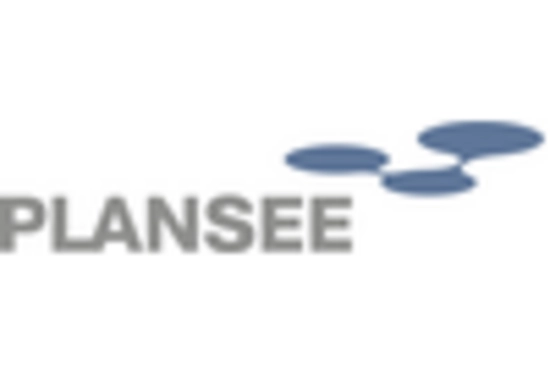Rising Investment in Renewable Energy
The shift towards renewable energy sources is creating new opportunities for the refractory metals market. These metals are increasingly used in the production of components for solar panels, wind turbines, and energy storage systems. The demand for high-performance materials that can withstand harsh environmental conditions is driving the adoption of refractory metals in renewable energy applications. Recent reports indicate that investments in renewable energy technologies are expected to reach unprecedented levels, with projections suggesting a growth rate of 8% annually. This trend indicates a strong potential for refractory metals to play a pivotal role in the transition to sustainable energy solutions, thereby enhancing their market presence.
Expansion in Electronics Manufacturing
The electronics manufacturing sector is increasingly adopting refractory metals due to their superior conductivity and thermal stability. These materials are utilized in various electronic components, including connectors, capacitors, and semiconductor devices. The refractory metals market is likely to benefit from the ongoing miniaturization of electronic devices, which demands materials that can perform reliably under high temperatures. Recent data suggests that the electronics sector is projected to grow at a rate of 6% annually, further driving the demand for refractory metals. As technology advances, the need for efficient and durable materials in electronics will likely enhance the market's growth trajectory, making refractory metals indispensable in modern electronic applications.
Increasing Demand in Aerospace and Defense
The aerospace and defense sectors are experiencing a notable surge in demand for refractory metals, primarily due to their exceptional heat resistance and mechanical properties. These materials are essential in manufacturing components such as turbine blades and rocket nozzles, which must withstand extreme temperatures and pressures. The refractory metals market is projected to grow as advancements in aerospace technology continue to evolve. According to recent estimates, the aerospace sector alone is expected to contribute significantly to the overall market growth, with a compound annual growth rate of approximately 5.5% over the next few years. This trend indicates a robust demand for high-performance materials, positioning refractory metals as a critical component in the future of aerospace and defense applications.
Growing Applications in Automotive Industry
The automotive industry is increasingly recognizing the value of refractory metals for high-performance applications. These materials are utilized in components such as exhaust systems, turbochargers, and catalytic converters, where heat resistance and durability are paramount. The refractory metals market is poised for growth as automotive manufacturers strive to enhance vehicle performance and efficiency. Recent market analyses indicate that the automotive sector is projected to grow at a rate of 4% annually, with a corresponding increase in the demand for advanced materials. This trend suggests that refractory metals will play a crucial role in the future of automotive engineering, particularly as the industry moves towards more efficient and environmentally friendly technologies.
Technological Innovations in Manufacturing Processes
Technological innovations in manufacturing processes are significantly impacting the refractory metals market. Advanced techniques such as additive manufacturing and powder metallurgy are enabling the production of complex geometries and improved material properties. These innovations are likely to enhance the efficiency and cost-effectiveness of refractory metal production, making them more accessible to various industries. Recent advancements suggest that the adoption of these technologies could lead to a reduction in production costs by up to 15%, thereby stimulating market growth. As industries seek to optimize their manufacturing processes, the demand for refractory metals is expected to rise, reflecting the importance of these materials in modern manufacturing.

















Leave a Comment